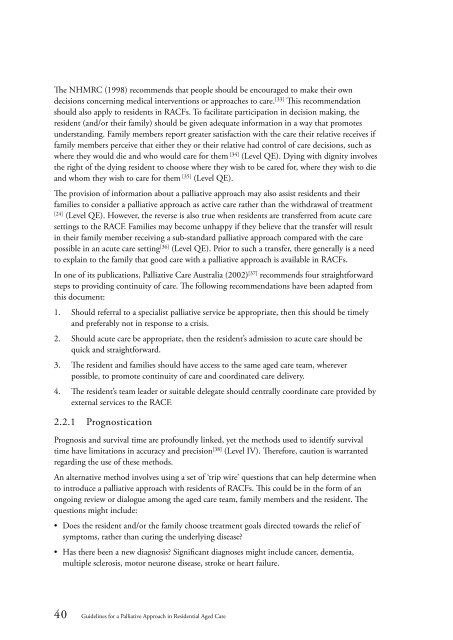Guidelines for a Palliative Approach in Residential Aged Care
Guidelines for a Palliative Approach in Residential Aged Care
Guidelines for a Palliative Approach in Residential Aged Care
You also want an ePaper? Increase the reach of your titles
YUMPU automatically turns print PDFs into web optimized ePapers that Google loves.
The NHMRC (1998) recommends that people should be encouraged to make their own<br />
decisions concern<strong>in</strong>g medical <strong>in</strong>terventions or approaches to care. [33] This recommendation<br />
should also apply to residents <strong>in</strong> RACFs. To facilitate participation <strong>in</strong> decision mak<strong>in</strong>g, the<br />
resident (and/or their family) should be given adequate <strong>in</strong><strong>for</strong>mation <strong>in</strong> a way that promotes<br />
understand<strong>in</strong>g. Family members report greater satisfaction with the care their relative receives if<br />
family members perceive that either they or their relative had control of care decisions, such as<br />
where they would die and who would care <strong>for</strong> them [34] (Level QE). Dy<strong>in</strong>g with dignity <strong>in</strong>volves<br />
the right of the dy<strong>in</strong>g resident to choose where they wish to be cared <strong>for</strong>, where they wish to die<br />
and whom they wish to care <strong>for</strong> them [35] (Level QE).<br />
The provision of <strong>in</strong><strong>for</strong>mation about a palliative approach may also assist residents and their<br />
families to consider a palliative approach as active care rather than the withdrawal of treatment<br />
[24]<br />
(Level QE). However, the reverse is also true when residents are transferred from acute care<br />
sett<strong>in</strong>gs to the RACF. Families may become unhappy if they believe that the transfer will result<br />
<strong>in</strong> their family member receiv<strong>in</strong>g a sub-standard palliative approach compared with the care<br />
possible <strong>in</strong> an acute care sett<strong>in</strong>g [36] (Level QE). Prior to such a transfer, there generally is a need<br />
to expla<strong>in</strong> to the family that good care with a palliative approach is available <strong>in</strong> RACFs.<br />
In one of its publications, <strong>Palliative</strong> <strong>Care</strong> Australia (2002) [37] recommends four straight<strong>for</strong>ward<br />
steps to provid<strong>in</strong>g cont<strong>in</strong>uity of care. The follow<strong>in</strong>g recommendations have been adapted from<br />
this document:<br />
1. Should referral to a specialist palliative service be appropriate, then this should be timely<br />
and preferably not <strong>in</strong> response to a crisis.<br />
2. Should acute care be appropriate, then the resident’s admission to acute care should be<br />
quick and straight<strong>for</strong>ward.<br />
3. The resident and families should have access to the same aged care team, wherever<br />
possible, to promote cont<strong>in</strong>uity of care and coord<strong>in</strong>ated care delivery.<br />
4. The resident’s team leader or suitable delegate should centrally coord<strong>in</strong>ate care provided by<br />
external services to the RACF.<br />
2.2.1 Prognostication<br />
Prognosis and survival time are profoundly l<strong>in</strong>ked, yet the methods used to identify survival<br />
time have limitations <strong>in</strong> accuracy and precision [38] (Level IV). There<strong>for</strong>e, caution is warranted<br />
regard<strong>in</strong>g the use of these methods.<br />
An alternative method <strong>in</strong>volves us<strong>in</strong>g a set of ‘trip wire’ questions that can help determ<strong>in</strong>e when<br />
to <strong>in</strong>troduce a palliative approach with residents of RACFs. This could be <strong>in</strong> the <strong>for</strong>m of an<br />
ongo<strong>in</strong>g review or dialogue among the aged care team, family members and the resident. The<br />
questions might <strong>in</strong>clude:<br />
• Does the resident and/or the family choose treatment goals directed towards the relief of<br />
symptoms, rather than cur<strong>in</strong>g the underly<strong>in</strong>g disease?<br />
• Has there been a new diagnosis? Significant diagnoses might <strong>in</strong>clude cancer, dementia,<br />
multiple sclerosis, motor neurone disease, stroke or heart failure.<br />
40 <strong>Guidel<strong>in</strong>es</strong> <strong>for</strong> a <strong>Palliative</strong> <strong>Approach</strong> <strong>in</strong> <strong>Residential</strong> <strong>Aged</strong> <strong>Care</strong>
















